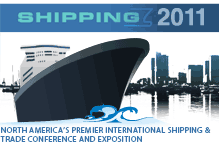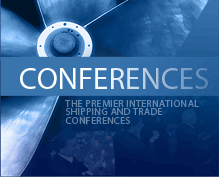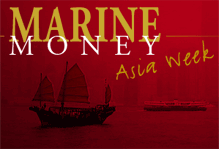
KG STRUCTURE – OPEN FOR MORE THAN BOXSHIPS
By Nicolai Heidenreich
Following-on from our KS article in our September issue we will take a brief look at the German KG market explaining the pros and cons putting it all into perspective with a recent deal. Again the focus of the article will be to explain the benefits from a shipowners perspective and next month we will continue this series by looking at a straight forward sale-leaseback and compare these three off balance sheet structures.
KG Structure
The KG structure or German Limited Partnership is a financial structure where most often a shipowner will sell and charter back his vessel to a special purpose company which is set up to primarily own the vessel during the charter hire period. The arranger of the structure will negotiate with banks and will sell the equity to a group of German private individuals who will use the investment to reduce their individual income tax.
Continue Reading
Oil and History
By Dr. Morris Mottale
Editor’s Note: During the contemplation of subject-matter for the September issue I was able to attend a guest lecture in New York regarding conflict in the middle east by an old university Professor of mine, Dr. Morris Mottale. We discussed his doing an article on the region as the region’s politics have a direct macro-economic impact on the globe and a significant impact on OPEC politics and therefore the micro-economy of the tanker trade.
What was difficult at the time was the contextual atmosphere whereby a macro-political piece would have specific relevance to the tanker and/or shipping markets and the idea went by the way-side for September. Obviously, September 11th provided the horrific context and relevance for the October issue.
Below Prof. Mottale implies that the differentiation between politics and business may no longer be possible as it will be dictated, more than ever before, by security concerns. This can and will affect trade and energy practices that could have sincere impact on how we ship oil and other goods. That obviously could alter shipping investment. His text follows, enjoy. – Urs M. Dür.
Continue Reading
OMI: Phoenix-Like
By Urs Dür
OMI Corporation (NYSE: OMM) was popularly thought, prior to the Erika, at about this point in 1999, to be a tanker company that might well be “on the ropes” and in danger of going “down for the count”. They were not alone in this situation in the tanker world. With the post-Erika boom market, they were able to re-focus the strategy of the company on their two main markets (Suezmax spot tankers and product tanker term business), revitalize their fleet profile, and engage in a new financing facility to change their balance sheet profile and improve their long-term outlook. The turn-around, even with all the abounding uncertainty, is one of the more interesting on the NY publicly traded tanker scene.
We look at some of the highlights from 2001 and discuss where the company is likely headed in the near term.
New Debt Facility
In our view, OMI’s 6-year revolving/reducing facility, closed July 27th 2001, was a great success. The deal was originally for $280m, but was oversubscribed and increased to $348m.
Continue Reading
EQUIMAR BREATHES!
The restructuring of B+H created equity, eliminated debt, enriched CBK and made one oblivious CBO bondholder very happy. Deemed by some to be little more than “a fleet of Erikas,” B+H’s recent 20-F filing reveals a company that has been transformed, and might even have a shot at fleet renewal.
A quick perusal of the B+H balance sheet tells the story of a company that magically transformed its shareholder’s equity from a negative $6 million to a positive $40 million. How was such a feat accomplished? Continue Reading
JAPAN – Finding the Dawn
By Geoff Uttmark
When Secretary of State Colin Powell visited Japan earlier this summer, the bi-lateral trade relationship that has come to symbolize both the similarities and differences between the world’s largest and second largest economies was undoubtedly high on his agenda. The U.S. – Japan Economic Partnership for Growth entered into by President Bush and Prime Minister Junichiro Koizumi on June 30th is only the latest of a long line of trade initiatives that date back to Admiral Mathew Perry’s visit to Tokyo Bay in 1853. The trade relationship between The Pacific Rivals* was contentious then, since Perry was an uninvited guest, and it is often still contentious today, given annual U.S. trade deficits with Japan of $70 to $80 billion. Never mind that the Japanese, on a per capita basis, actually consume more U.S. goods and services than vice versa. Details like this rarely influence populist rhetoric. But at senior policy-making levels on both sides of the Pacific there is acute awareness that together Japan and the U.S. account for fully 42 percent of all global production with economies that are fiscally, economically and strategically interdependent at many levels. The U.S., for instance, is Japan’s leading trading partner while Japan is the number one destination for U.S. agricultural exports and third overall for all U.S. exports. Beyond the bilateral relationship, Japan sits geographically atop the Indo – Asia – Australia triangle (Figure 1) within which the aggregate value of her foreign trade is equal to her trade with the U.S. The strong linkage of economic, strategic and financial interests is undoubtedly one reason why the Secretary of State headed for Japan instead of the Secretary of Commerce.
Off Balance Sheet Financing – The Norwegian KS Structure
By Nicolai Heidenreich
Many larger industrial companies who control a sizable fleet are looking to minimize the asset exposure on their balance sheet. Off-balance sheet financing has again become very popular. In a three part series Marine Money will cover three different types of off-balance sheet financing. This first article will look at the Norwegian Limited Partnership (KS) as a structure and briefly explain what benefits the shipowner can have by entering into such an agreement. In the two next articles we will look at the KG and more straightforward capital lease structure. This will include, from an owners point of view, an in-depth comparison of the many different features of the three financing options.
Brief Description
To be considered a single purpose limited partnership (kommandittselskap (KS)) under the Norwegian Companies Act (NCA), the KS must consist of one general partner and several limited partners. The general partner (komplementaren) must hold a minimum share of 10% in the KS and has unlimited liability towards the company’s creditors. The limited partners’ obligations are limited to each partner’s share of the total committed capital, (including bank guarantee) of the KS. However the limited partner’s hold a joint liability towards the KS if one the other limited partners default on their obligations.
Continue Reading
The Other 30%
By Matt McCleery
First mortgage financing will always account for 70% of the capital formation in the shipping industry. And why shouldn’t it? It’s dirt cheap, it’s flexible and it’s abundant. But in our view, financing the other 30% is where the business gets fun. Optimizing the other 30% allows for more leverage, higher returns on equity, lower operating break-even and frees up buying power to do more deals. The other 30% can transform a shipbroker into a shipowner, a spectator into a principal and, in the eyes of a banker, a toad into a prince. Put another way, the other 30% is what has attracted many of us to this industry.
In this September issue of Marine Money, we celebrate the unofficial beginning of the new business year by looking at the various ways the other 30% can be financed. Urs Dur begins the issue with a look at Seaspan which achieved relatively unique junior mezzanine for which Fortis created an investment grade commercial paper product. Nicolai Heidenreich analyzes the American Bulker KS transaction completed by Lasco a few months ago, and explores the depth and breadth of liquidity for the other 30% in the Norwegian KS market. Kevin Oates provides insight into the Royal Bank of Scotland, one of the most reliable mortgage lenders in the business. Finally, Geoff Uttmark presents a case why we think Japan is the land of opportunity for ship financiers and shipowners.
Continue Reading
From the Editor
NET ASSET VALUE AND TANKER EQUITIES
Marine Money has in the past often looked at NAV as a baseline for valuing a tanker stock. This is largely for the reason that everyone else seems to like it as a baseline, or if they do not like it, they accept it because, well, “everybody else does”. So what are we, a bunch of lemmings following the leader over the cliff? Is that what the general investing community should think of the tanker sector investors? In both cases, no.
On any of the tanker peer group noted in the below table, there are multiple reasons behind the valuation. For instance, Stelmar has been able to maintain a stronger overall valuation as its term business is perceived as value-added vis a vis its spot dependant brethren and, at the moment, is thought to have growth potential. OSG, for example, on which we do not currently have a NAV, has a high Price/Estimate Earnings (and we have calculated earnings on a pre-tax basis to level the playing field with the peers who all report as offshore and pre-tax) due somewhat to the fact that it is the old NY tanker mainstay. People have it and hold it.
Continue Reading
Seaspan – Front and Center
By Urs M. Dür
Due to the creativity of the refinancing and the size of the vessels involved, Marine Money believes that the following is amongst the most interesting stories developing publicly in the marine finance field today: Seaspan Container Lines Ltd (SCLL). SCLL, a division of the Washington Marine group, which took delivery of its first 4,250 teu vessel, CSCL Hamburg, in July of this year and has four more ex Samsung of the same size on the way, has set sail partially financed by products which resemble those used in aircraft leasing.
Seaspan Container Lines is the brainchild of Gerry Wang, longtime executive for Seaspan, formerly of Shanghai Maritime and China Merchants/Ming Wah and Kyle Washington, son of the Chairman of the privately held Washington Companies’ Dennis Washington. Messers Wang and (Kyle) Washington sit on the five-man board of SCLL. The other members are Jay Winship of San Diego based investment bankers Batchelder & Partners, Brent Geen, President of the Washington Marine Group and Graham Porter, Vice President of SCLL. The three main equity holders in SCLL are Washington Marine and Messrs Wang and Porter. While SCLL has just taken delivery of its first vessel, the goal is to own 20 or more large ocean-going containerships, some, see below, amongst the largest in the world.
Continue Reading
The Royal Bank of Scotland plc in Greece
By Kevin Oates
Introduction
Speak to most banks these days involved in ship financing and you definitely get the feeling that plain vanilla is… well…just too plain. The trend is definitely towards bigger, sexier deals which will result in arrangement fees as well as margins, as little perceived risk as possible either by lending on the back of a strong balance sheet or against secure long-term employment and essentially using as minute a portion as possible of their own balance sheet. That is why some of the big boys of shipping finance like Citibank and JP Morgan Chase, and many of the large European lenders, are heard of less these days but are nonetheless participating in the big deals as much as ever. Not so much as prime lender but as prime arranger.
It makes a change therefore that one major shipping bank with a global portfolio of about $4 billion is quite happy continuing to lend on a bilateral basis and surviving basically on margin, fee and direct ancillary business from the lending relationships. Not only that but over 60% of the shipping portfolio concerns Greek related lending. This too is something which is not near the top of the list of most major lenders. Over the years the bank has had various advertising slogans including “The Twenty Year Men” reflecting the fact that a number of the senior shipping executives in the bank have worked within the shipping department for over 20 years, and “The Shipowners Club” giving the impression that membership to the clientele is somewhat restricted. The bank is, of course, The Royal Bank of Scotland.
Continue Reading







